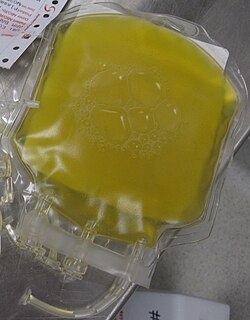Hemotherapy
Hemotherapy is the replacement of a certain part of the blood. It is the transfer of biological material from the donor organism to the recipient organism.[1]
Types of biological material[edit | edit source]
We distinguish blood derivatives and transfusion products.
- Transfusion products
It is a biological material, which is served to the recipient directly (or sometimes after deleucotization and / or irradiation) after collection. [1] Examples are erythrocyte concentrate (erythrocyte mass, "erymass"), platelet concentrate and fresh frozen plasma (fresh frozen plasma, FFP).
- Blood derivates
It is a material made from the donor's biological material by various biochemical-physical processes. [1] For example are IV immunoglobulins ("ivigy") or individual coagulation factors (except recombinant ones).
Principles of expedient hemotherapy[edit | edit source]
The patient's benefit should outweigh the risk of possible complications of hemotherapy (urticaria, febrile reactions, hemolysis, TRALI, iron overload…). Concurrently, it is important to find out the cause of the deficiency.
For example in sideropenic anaemia, it is not appropriate to substitute erythrocytes. We substitute iron. [1] Or in ITP, there is no sense in substituting platelets other than for vital indications, because they are immediately destroyed by antibodies. [1]
Indication[edit | edit source]
Hemotherapeutic substitution is needed in cases of anemia, thrombocytopenia a coagulopathy.
Submission of fresh frozen plasma as a volume expander is not indicated. [1]
Anemia[edit | edit source]
The classic recommendation states that erythrocytes should be substituted when hemoglobin values are lower than 80 g / l, unless the patient is suffering from ischemia or severe infection. [1] An exception is sideropenic anemia, for which it is more appropriate to substitute iron. For elderly patients with ischemia (ICHS, ICHDK etc.) or patients with sepsis is advisable to substitute earlier. The limits are chosen individually according to the condition, often when hemoglobin values are lower than 100 g / l. [1]
Clinical instruction states that for a healthy adult who does not bleed or undergo hemolysis, it increases by about 10 g / l after acceptation of a single erymass. [1]Usually are served two transfusions for adult patients - for operational reasons. If a substitution is indicated, it should be performed sufficiently.[1]
Hypertransfusion is useful in case of paroxysmal nocturnal hemoglobinuria and sick cell disease.[1]
For substitution is most often used erythrocyte mass. Whole blood is used only in war medicine (or in developing countries).[1]
Trombocytopenia[edit | edit source]
It is pointless to substitute platelets (even et zero values) in the case of immune thrombocytopenic purpura and thrombotic thrombocytopenic purpura. Substituted platelets are rapidly destroyed and the immune system is more sensitized. [1] Substitution is necessary in case of vital indication for unstoppable bleeding. For other thrombocytopenias, the cut-off value is considered to be a platelet count 10 . 109/l, after which it is expedient to substitute platelets. [1] If a patient with thrombocytopenia also has a fever or coagulopathy, it is advisable to substitute the platelets earlier. [1]
The requested platelet values for invasive procedures are:
- at least 50×109/l for venous cannula insertion or lumbal punction,
- at least 80×109/l before less complicated operations,,
- at least 100×109/l before more complicated operations. [1]
(However, achieving these values is not always entirely realistic in hematology.)
Platelet concentrates can be served either mixed (mixed from several donors to achieve sufficient amount) or from platelet spheroids, which are from one donor and therefore less sensitizing.[1]
Coagulopathy[edit | edit source]
The need for fresh frozen plasma is indicated:
- to substitute coagulation factors because of their deficiency (haemophilia, if individual factors are not available, etc.),
- for substitution in DIC,
- in case of Warfarin intoxication, if it is desirable to reduce INR rapidly and prothrombin complex is not available,
- for exchange plasmapheresis in TTP.[1]
When the acceptance of fresh-frozen plasma is indicated, it is expedient to substitute it in a sufficient amount, even more than 10-20 ml / kg. Concurrently, each preparation must be served immediately after thawing, because coagulation factors have a short half-time.[1]


